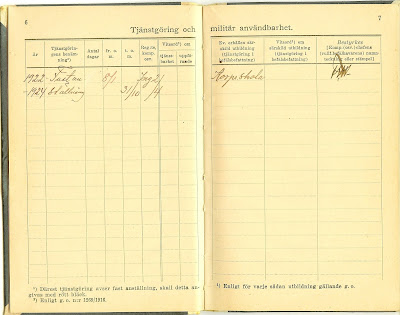Today we'll be adding to our current thread of Swedish Military items. I recently picked up a very rare Soldier's Book from 1924 and a Call-Up Postcard for the same soldier. Both items are very seldom seen here in the US!
I am not a Swedish speaker, so I will do my best to explain this little book and how it fits in with the old Swedish Military Conscription System. There is very little information published about these little books and even less that explains what is included inside them. I did however, find a wonderful genealogy website that is published in both Swedish and English, that has a very good description of a couple of similar books (1907 and 1940). It also does a great job of explaining the old Swedish Conscript System. I encourage anyone who is interested to check it out:
http://www.hhogman.se/swegen.htm
http://www.hhogman.se/enrollment_book_conscripts_1907.htm
These little books were given to each soldier when he first reported for his mandatory military service. The book was his personal military record and it was expected to be kept by the soldier at all times as proof and record of his service. These books were known as the Inskrivningsbok.
This particular book was issued to Bengt Vilhelm Dahlen, born in 1904. Inside the book, it notes that he first served with the Göta Ingenjörregemente Ing. 2, in 1922 (Göta Engineer Regiment 2), and then served with the Bodens Ingenjörregemente Ing. 4 in 1924 (Bodens Engineer Regiment 4).
https://en.wikipedia.org/wiki/G%C3%B6taland_Engineer_Regiment
https://en.wikipedia.org/wiki/Boden_Engineer_Regiment
It is interesting to note that the Model 94/14 Carbine Ammo Pouch that I covered in a previous post, was also issued to the Göta Engineer Regiment 2, Ing. 2. Who knows, this very same soldier may have actually carried that ammo pouch..........
http://sharky-fourbees.blogspot.com/2016/08/swedish-m9414-mauser-carbine-ammo-pouch.html
The personal information listed in the book for Bengt Dahlen, shows that his civilian occupation was Forestry Worker, "Skogs Arb". The fact that the hand written notations in the book are in Swedish, and they are written in a "difficult to read cursive", I will have to leave things there. If anyone reading this can shed some more light on the information inside the book, please contact me!
UPDATE 10/10/16: Thank you to Hans Högman in Sweden, for the following additional information. http://www.hhogman.se/hem.htm
“Korp.skola”
in the enrollment book is short for “korpralskola” which literally
means corporal school. So, this person had been to a training class to
become a corporal.
On
the same page, to the left we have the phrase “Fast anställning” (split
on two lines) which means “regular employment”. I looks like Dahlén was
enlisted as a professional soldier (not a draftee) between January
8,1922 and October 31, 1924.
Dahlén was born on April 5, 1904."
The person I bought this book from, also had his US passport that was issued in 1964. He told me that he acquired a bundle of personal papers at an estate auction, and these were in that purchase. From what we can determine, he immigrated to the USA in the early 1960's, married, and became a naturalized US citizen. It appears that he lived in New York City, in one of the predominantly Swedish neighborhoods at that time. I did not acquire the passport, but I do have a few photos of it.
 |
| US Passport |
In the back of the little Soldier's book, there is a pocket that contains a "Conscription Call-Up Post Card". These were know as Militära tjänstebrevkort (MTjbK). These cards were mailed out to notify each soldier of the time, place and unit that he was to report to for his annual or special service. The postmark on this card is 1925, with Bengt Dahlen's name.
That is about all I can tell about this little Soldier's Book right now, so I will let the photos and scans of the pages speak for themselves. In the interest of historical documentation, I have scanned and included ALL of the pages in this album! Enjoy!
 |
| Entries showing service with Ing.2 in 1922, and Ing.4 in 1924. |
 |
| Pocket in back of book with "Call-Up Card". |
































